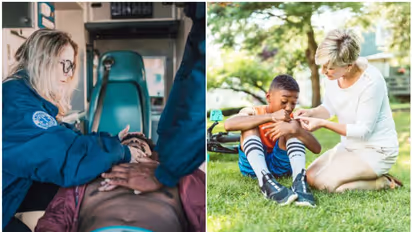Essential First-Aid Tips: 7 must-know techniques for emergency situations

Synopsis
Discover seven crucial first-aid tips that everyone should know. From CPR and treating wounds to recognizing signs of stroke and managing fractures, empower yourself to provide immediate assistance in emergencies.
Having basic first-aid knowledge is essential for anyone, as it empowers you to provide immediate assistance in various emergencies. Remember, these tips are not a substitute for formal first-aid training. Consider enrolling in a certified first-aid course to gain in-depth knowledge and practical skills. The ability to provide timely first-aid assistance can make a significant difference in saving lives and minimizing the impact of injuries or medical emergencies.
Here are seven first-aid tips that you must know:
1. CPR (Cardiopulmonary Resuscitation)
CPR is a life-saving technique used in cases of cardiac arrest. It involves chest compressions and rescue breaths to maintain blood circulation and oxygenation until professional help arrives. Learn CPR techniques from certified training programs and remember to call emergency services before starting CPR.
2. Heimlich maneuver
The Heimlich maneuver is used to dislodge a blockage in the airway, particularly in cases of choking. Stand behind the person and place your arms around their waist. Make a fist with one hand, place it just above the navel, and grip it with your other hand. Deliver quick upward thrusts to forcefully expel the obstruction. If the person becomes unconscious, start CPR immediately.
3. Treating wounds
Proper wound care is crucial to prevent infection. Clean the wound with mild soap and running water. If the wound is bleeding, apply gentle pressure using a clean cloth or sterile dressing to control it. Cover the wound with a sterile bandage or dressing. Seek medical attention if the wound is deep, heavily bleeding, or shows signs of infection, such as increased redness, swelling, or pus.
4. Dealing with fractures
If you suspect a bone fracture, encourage the person to remain still and support the injured area. If available, use splints or improvised materials to immobilize the fracture. Apply ice packs wrapped in a cloth to reduce swelling and provide pain relief. Seek medical help promptly for further evaluation and treatment.
5. Managing burns
For minor burns, cool the affected area under cool (not cold) running water for about 10-20 minutes. Avoid using ice or very cold water. Cover the burn with a clean, non-stick dressing. For severe burns, call emergency services immediately and, if possible, elevate the burned area above the heart level while waiting for help.
6. Recognizing signs of a stroke
Remember the acronym FAST to identify potential signs of a stroke: Face drooping, Arm weakness, Speech difficulty, and Time to call emergency services. If you observe any of these signs, act quickly and seek medical attention. Note the time when the symptoms started, as it is important information for healthcare professionals.
7. Allergic reactions and anaphylaxis
In the case of severe allergic reactions or anaphylaxis, prompt action is crucial. If someone is experiencing difficulty breathing, swelling of the face or throat, or widespread hives, call emergency services immediately. If the person has a prescribed epinephrine auto-injector, help them administer it according to the instructions. Stay with the person until medical professionals arrive.
Explore the latest Lifestyle News covering fashion, wellness, travel, Food and Recipes, and more. Stay updated with trending Health News, fitness tips, and expert insights to inspire your daily living. Discover personalized lifestyle trends that keep you stylish and informed. Download the Asianet News Official App from the Android Play Store and iPhone App Store for everything that adds value to your everyday life.